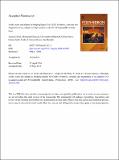Files in this item
Azide, water and adipate as bridging ligands for Cu(II) : synthesis, structure and magnetism of (μ4-adipato-κ-O)(μ-aqua)(μ-azido-κN1,N1)copper(II) monohydrate
Item metadata
| dc.contributor.author | Setifi, Zouaoui | |
| dc.contributor.author | Ghazzali, Mohamed | |
| dc.contributor.author | Glidewell, Christopher | |
| dc.contributor.author | Pérez, Olivier | |
| dc.contributor.author | Setifi, Fatima | |
| dc.contributor.author | Gómez-García, Carlos J. | |
| dc.contributor.author | Reedijk, Jan | |
| dc.date.accessioned | 2017-06-03T23:33:27Z | |
| dc.date.available | 2017-06-03T23:33:27Z | |
| dc.date.issued | 2016-10-15 | |
| dc.identifier | 243306240 | |
| dc.identifier | 83bfaf99-db54-43e8-8881-47062185f72a | |
| dc.identifier | 84975322650 | |
| dc.identifier | 000384384500029 | |
| dc.identifier.citation | Setifi , Z , Ghazzali , M , Glidewell , C , Pérez , O , Setifi , F , Gómez-García , C J & Reedijk , J 2016 , ' Azide, water and adipate as bridging ligands for Cu(II) : synthesis, structure and magnetism of (μ4-adipato-κ-O)(μ-aqua)(μ-azido-κN1,N1)copper(II) monohydrate ' , Polyhedron , vol. 117 , pp. 244-248 . https://doi.org/10.1016/j.poly.2016.05.060 | en |
| dc.identifier.issn | 0277-5387 | |
| dc.identifier.other | RIS: urn:80FF2E7C35F20B8DC154C8F25E6E1449 | |
| dc.identifier.uri | https://hdl.handle.net/10023/10904 | |
| dc.description | The Distinguished Scientist Fellowship Program (DSFP) at King Saud University is gratefully acknowledged. The authors are grateful to the Algerian MESRS (Ministère de l’Enseignement Supérieur et de la Recherche Scientifique), the Université Ferhat Abbas Sétif 1, the KSU DSFP program and the Spanish MINECO (CTQ2014-52758-P and MAT2014-56143-R) and the Generalitat Valenciana (PrometeoII/2014/076) for financial support. | en |
| dc.description.abstract | The synthesis, characterization, single crystal structure and magnetic properties of the compound [(CuN3(OH2))2(adp)]n (1) are presented, in which adp stands for the adipate(2-) anion. This compound consists of layers containing chains of six-coordinated Cu(II) ions; the chains are connected by μ4adipate anions. The magnetically interesting part of the compound is the Cu(II) chain, built from 3 bridging ligands, i.e. a water ligand, an azide anionic ligand bridging by using a terminal N atom to connect 2 Cu(II) ions, and one symmetrically bridging carboxylato group of adipate; the other end of the tetradentate adipate anions symmetrically connect the chains, forming the layers. From the magnetic point of view the compound is considered as a Cu(II) chain with a quite unusual, symmetrical water bridge, the μ-syn-syn carboxylate and the μ-N3 bridge. The bridging water also hydrogen bonds to a terminal N of a nearby azido ligand. Magnetic susceptibility measurements show that 1 presents moderate ferromagnetic intrachain interactions (Jchain = +38.4 cm-1) with a metamagnetic behaviour for the inter-chain interaction with a critical field of 0.7 T. | |
| dc.format.extent | 5 | |
| dc.format.extent | 2162889 | |
| dc.language.iso | eng | |
| dc.relation.ispartof | Polyhedron | en |
| dc.subject | Copper | en |
| dc.subject | Adipate | en |
| dc.subject | Azide | en |
| dc.subject | Ferromagnetic chain | en |
| dc.subject | Metamagnet | en |
| dc.subject | Water bridge | en |
| dc.subject | QD Chemistry | en |
| dc.subject | NDAS | en |
| dc.subject.lcc | QD | en |
| dc.title | Azide, water and adipate as bridging ligands for Cu(II) : synthesis, structure and magnetism of (μ4-adipato-κ-O)(μ-aqua)(μ-azido-κN1,N1)copper(II) monohydrate | en |
| dc.type | Journal article | en |
| dc.contributor.institution | University of St Andrews. School of Chemistry | en |
| dc.identifier.doi | https://doi.org/10.1016/j.poly.2016.05.060 | |
| dc.description.status | Peer reviewed | en |
| dc.date.embargoedUntil | 2017-06-03 |
This item appears in the following Collection(s)
Items in the St Andrews Research Repository are protected by copyright, with all rights reserved, unless otherwise indicated.

